Historical Essay: War and Peace, Revolutions, and Masculinity
VerifiedAdded on 2022/11/11
|5
|1173
|213
Essay
AI Summary
This essay provides a historical analysis of war and peace, focusing on the French Revolution and Napoleonic Wars. It examines two articles: one discussing testimonies of atrocities during the wars and the experiences of veterans, and the other exploring the association of masculinity with soldierly conduct and citizenship. The essay delves into the horrors of war, the perspectives of both perpetrators and victims, and the impact of revolutionary ideals on gender roles and national identity. It highlights themes of suffering, destruction, power, patriotism, and the lasting influence of these historical events on subsequent generations. The essay uses primary and secondary sources to explore the complexities of war and its impact on individuals and society.
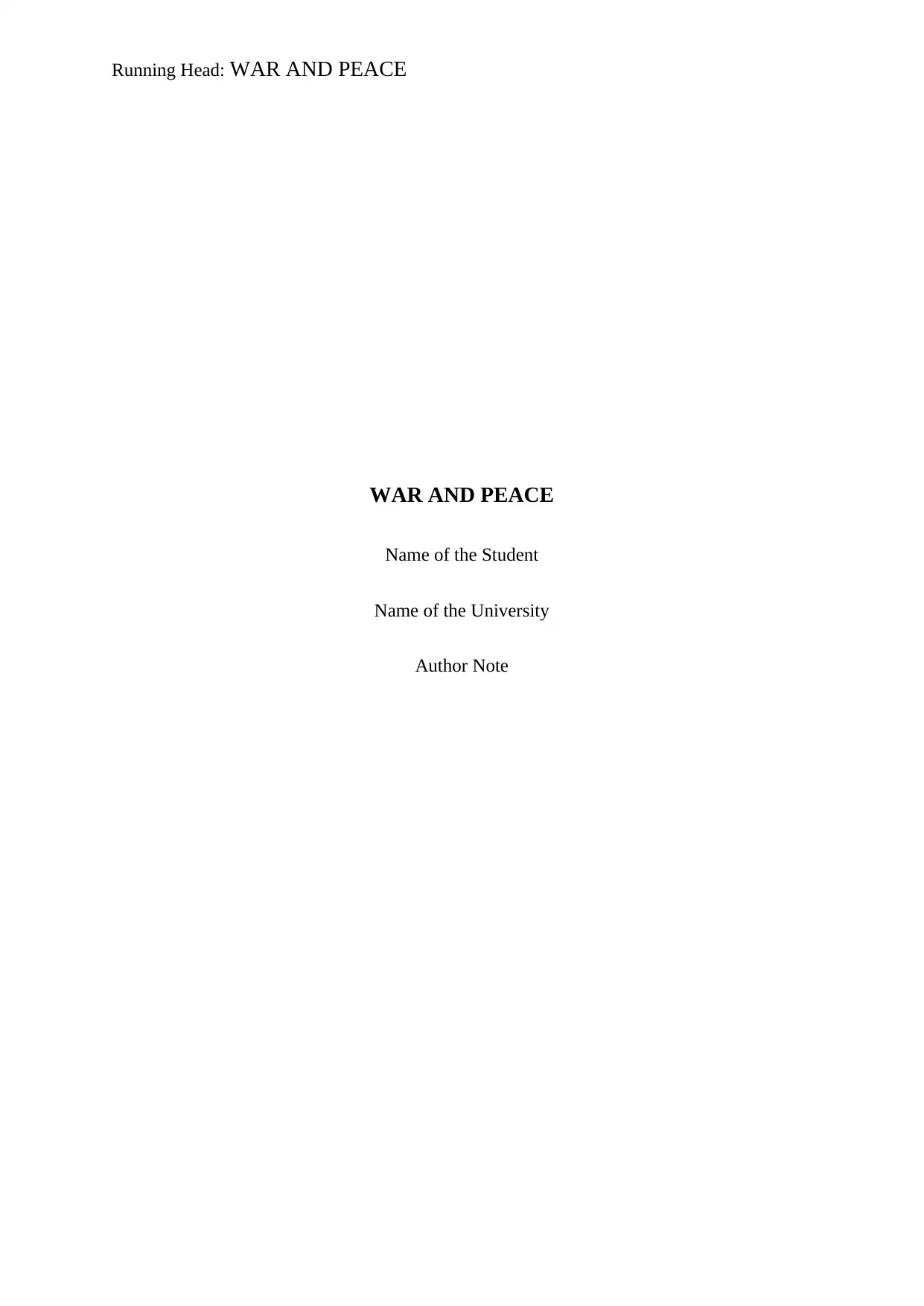
Running Head: WAR AND PEACE
WAR AND PEACE
Name of the Student
Name of the University
Author Note
WAR AND PEACE
Name of the Student
Name of the University
Author Note
Paraphrase This Document
Need a fresh take? Get an instant paraphrase of this document with our AI Paraphraser
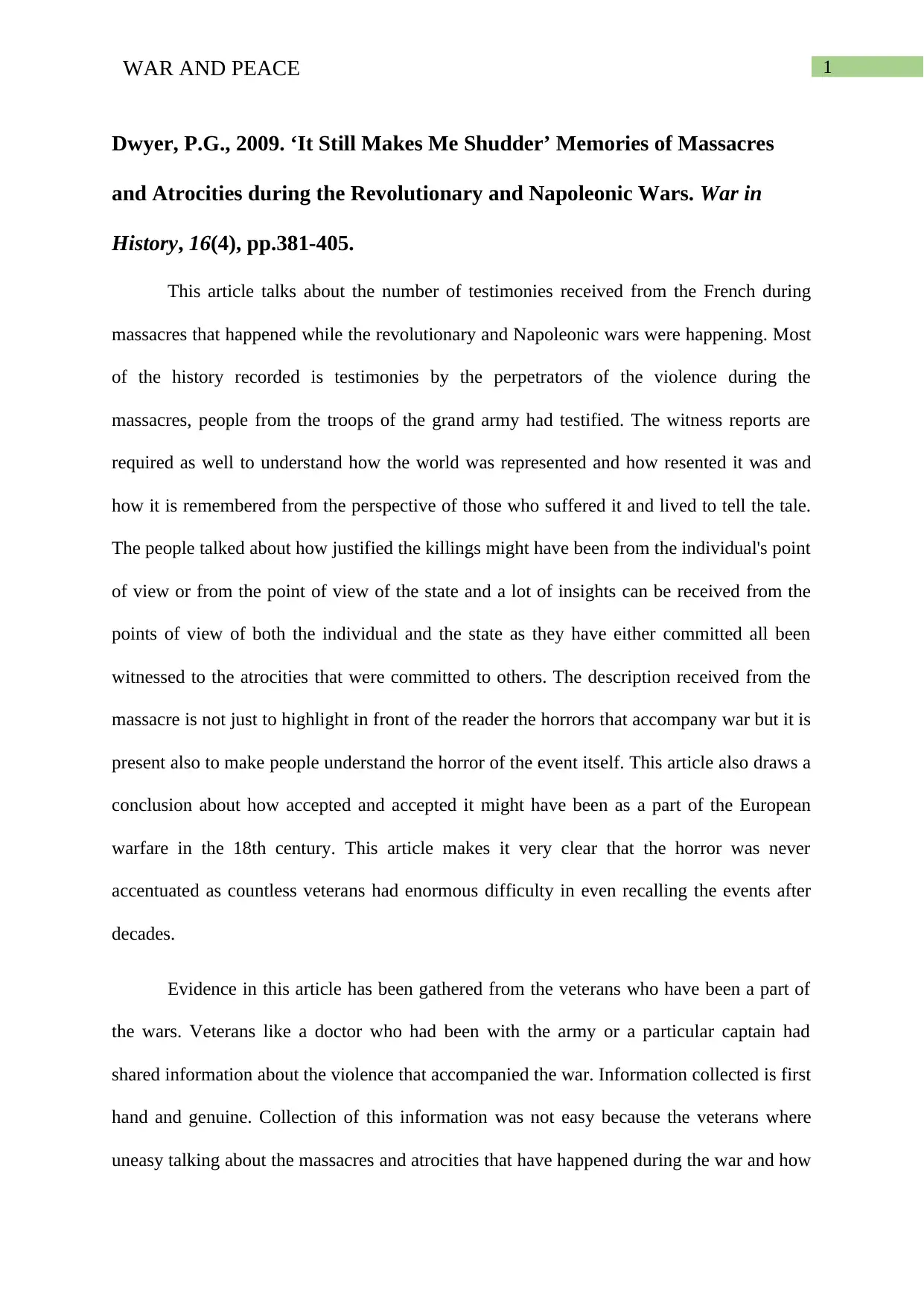
1WAR AND PEACE
Dwyer, P.G., 2009. ‘It Still Makes Me Shudder’ Memories of Massacres
and Atrocities during the Revolutionary and Napoleonic Wars. War in
History, 16(4), pp.381-405.
This article talks about the number of testimonies received from the French during
massacres that happened while the revolutionary and Napoleonic wars were happening. Most
of the history recorded is testimonies by the perpetrators of the violence during the
massacres, people from the troops of the grand army had testified. The witness reports are
required as well to understand how the world was represented and how resented it was and
how it is remembered from the perspective of those who suffered it and lived to tell the tale.
The people talked about how justified the killings might have been from the individual's point
of view or from the point of view of the state and a lot of insights can be received from the
points of view of both the individual and the state as they have either committed all been
witnessed to the atrocities that were committed to others. The description received from the
massacre is not just to highlight in front of the reader the horrors that accompany war but it is
present also to make people understand the horror of the event itself. This article also draws a
conclusion about how accepted and accepted it might have been as a part of the European
warfare in the 18th century. This article makes it very clear that the horror was never
accentuated as countless veterans had enormous difficulty in even recalling the events after
decades.
Evidence in this article has been gathered from the veterans who have been a part of
the wars. Veterans like a doctor who had been with the army or a particular captain had
shared information about the violence that accompanied the war. Information collected is first
hand and genuine. Collection of this information was not easy because the veterans where
uneasy talking about the massacres and atrocities that have happened during the war and how
Dwyer, P.G., 2009. ‘It Still Makes Me Shudder’ Memories of Massacres
and Atrocities during the Revolutionary and Napoleonic Wars. War in
History, 16(4), pp.381-405.
This article talks about the number of testimonies received from the French during
massacres that happened while the revolutionary and Napoleonic wars were happening. Most
of the history recorded is testimonies by the perpetrators of the violence during the
massacres, people from the troops of the grand army had testified. The witness reports are
required as well to understand how the world was represented and how resented it was and
how it is remembered from the perspective of those who suffered it and lived to tell the tale.
The people talked about how justified the killings might have been from the individual's point
of view or from the point of view of the state and a lot of insights can be received from the
points of view of both the individual and the state as they have either committed all been
witnessed to the atrocities that were committed to others. The description received from the
massacre is not just to highlight in front of the reader the horrors that accompany war but it is
present also to make people understand the horror of the event itself. This article also draws a
conclusion about how accepted and accepted it might have been as a part of the European
warfare in the 18th century. This article makes it very clear that the horror was never
accentuated as countless veterans had enormous difficulty in even recalling the events after
decades.
Evidence in this article has been gathered from the veterans who have been a part of
the wars. Veterans like a doctor who had been with the army or a particular captain had
shared information about the violence that accompanied the war. Information collected is first
hand and genuine. Collection of this information was not easy because the veterans where
uneasy talking about the massacres and atrocities that have happened during the war and how
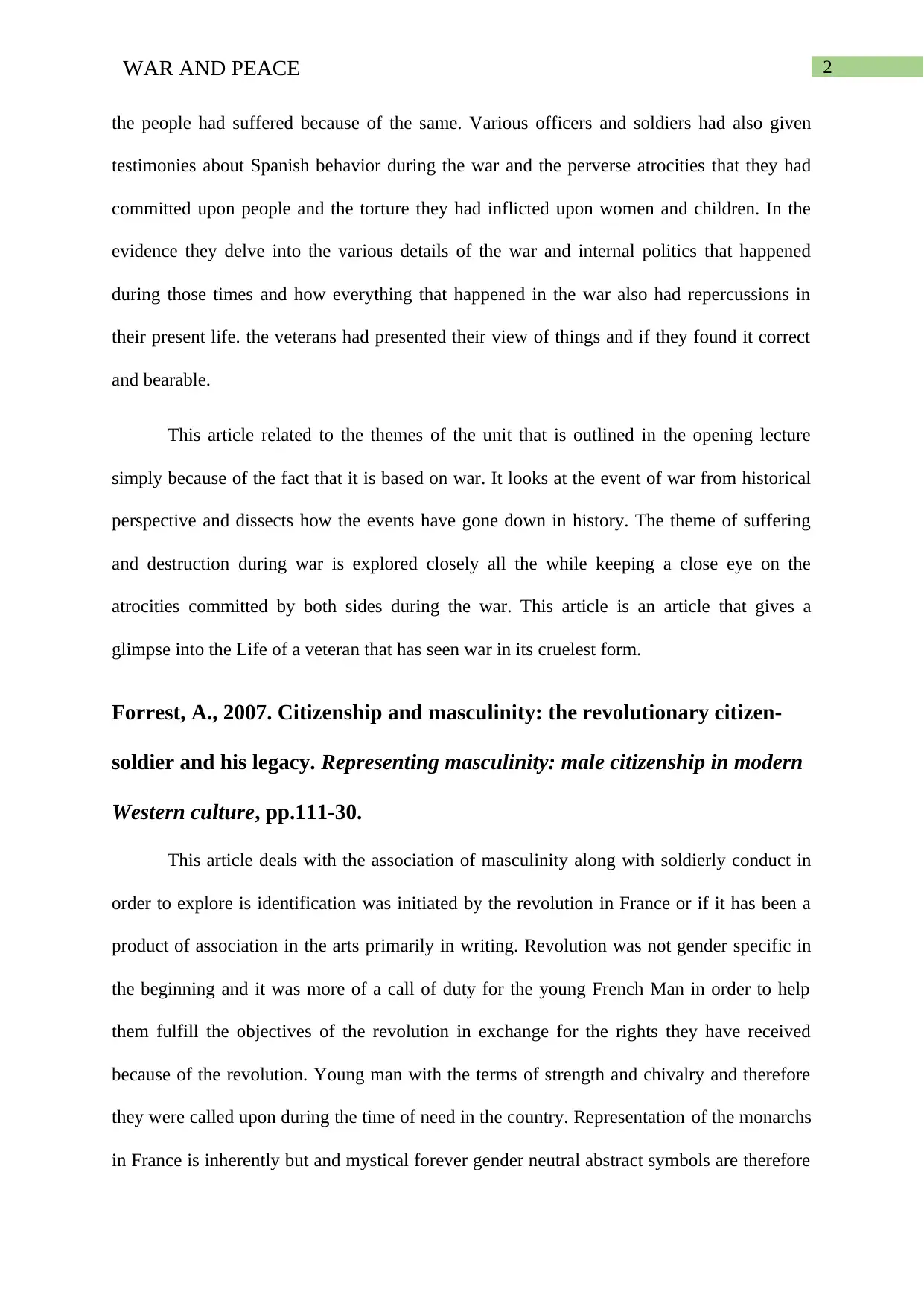
2WAR AND PEACE
the people had suffered because of the same. Various officers and soldiers had also given
testimonies about Spanish behavior during the war and the perverse atrocities that they had
committed upon people and the torture they had inflicted upon women and children. In the
evidence they delve into the various details of the war and internal politics that happened
during those times and how everything that happened in the war also had repercussions in
their present life. the veterans had presented their view of things and if they found it correct
and bearable.
This article related to the themes of the unit that is outlined in the opening lecture
simply because of the fact that it is based on war. It looks at the event of war from historical
perspective and dissects how the events have gone down in history. The theme of suffering
and destruction during war is explored closely all the while keeping a close eye on the
atrocities committed by both sides during the war. This article is an article that gives a
glimpse into the Life of a veteran that has seen war in its cruelest form.
Forrest, A., 2007. Citizenship and masculinity: the revolutionary citizen-
soldier and his legacy. Representing masculinity: male citizenship in modern
Western culture, pp.111-30.
This article deals with the association of masculinity along with soldierly conduct in
order to explore is identification was initiated by the revolution in France or if it has been a
product of association in the arts primarily in writing. Revolution was not gender specific in
the beginning and it was more of a call of duty for the young French Man in order to help
them fulfill the objectives of the revolution in exchange for the rights they have received
because of the revolution. Young man with the terms of strength and chivalry and therefore
they were called upon during the time of need in the country. Representation of the monarchs
in France is inherently but and mystical forever gender neutral abstract symbols are therefore
the people had suffered because of the same. Various officers and soldiers had also given
testimonies about Spanish behavior during the war and the perverse atrocities that they had
committed upon people and the torture they had inflicted upon women and children. In the
evidence they delve into the various details of the war and internal politics that happened
during those times and how everything that happened in the war also had repercussions in
their present life. the veterans had presented their view of things and if they found it correct
and bearable.
This article related to the themes of the unit that is outlined in the opening lecture
simply because of the fact that it is based on war. It looks at the event of war from historical
perspective and dissects how the events have gone down in history. The theme of suffering
and destruction during war is explored closely all the while keeping a close eye on the
atrocities committed by both sides during the war. This article is an article that gives a
glimpse into the Life of a veteran that has seen war in its cruelest form.
Forrest, A., 2007. Citizenship and masculinity: the revolutionary citizen-
soldier and his legacy. Representing masculinity: male citizenship in modern
Western culture, pp.111-30.
This article deals with the association of masculinity along with soldierly conduct in
order to explore is identification was initiated by the revolution in France or if it has been a
product of association in the arts primarily in writing. Revolution was not gender specific in
the beginning and it was more of a call of duty for the young French Man in order to help
them fulfill the objectives of the revolution in exchange for the rights they have received
because of the revolution. Young man with the terms of strength and chivalry and therefore
they were called upon during the time of need in the country. Representation of the monarchs
in France is inherently but and mystical forever gender neutral abstract symbols are therefore
⊘ This is a preview!⊘
Do you want full access?
Subscribe today to unlock all pages.

Trusted by 1+ million students worldwide
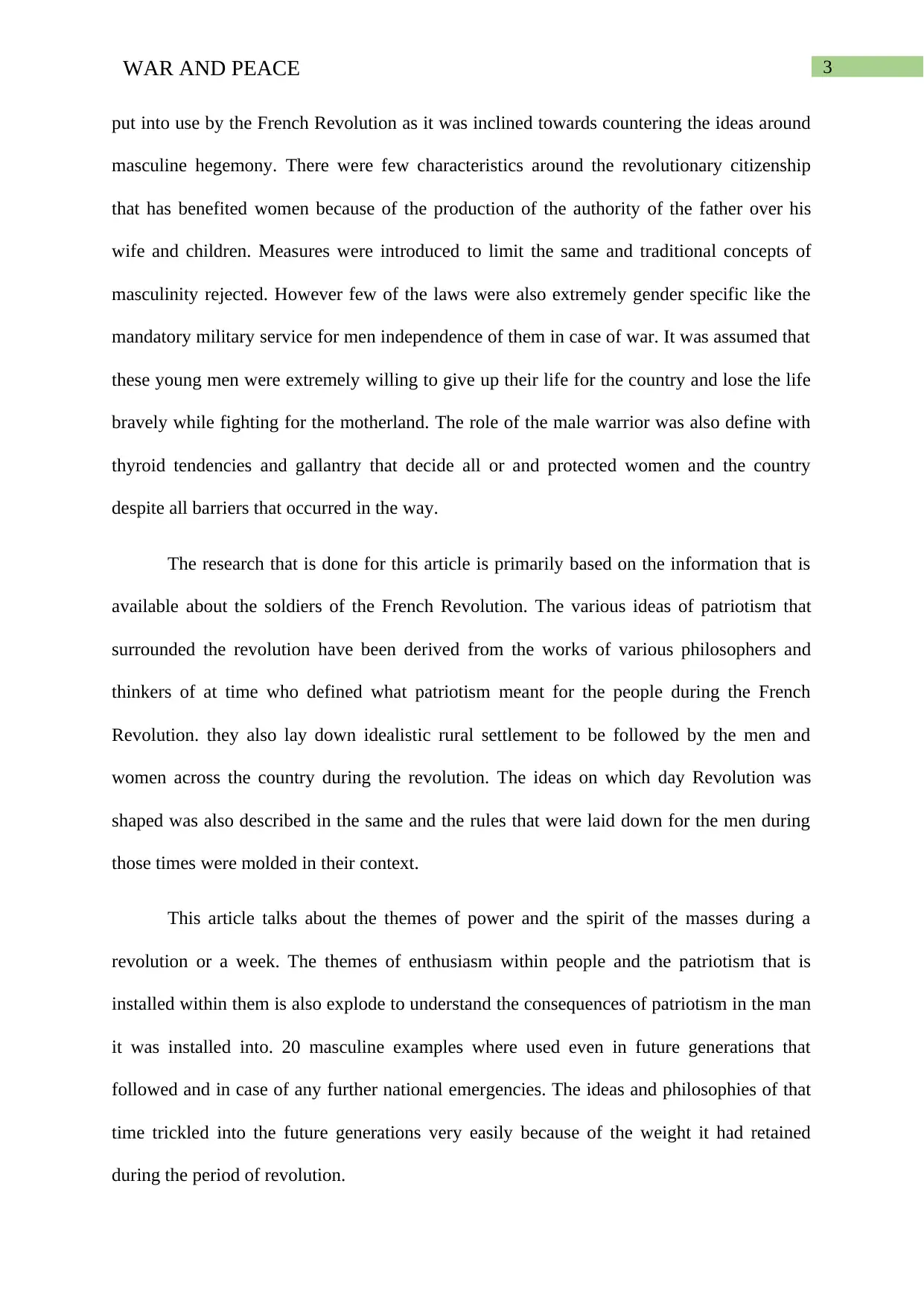
3WAR AND PEACE
put into use by the French Revolution as it was inclined towards countering the ideas around
masculine hegemony. There were few characteristics around the revolutionary citizenship
that has benefited women because of the production of the authority of the father over his
wife and children. Measures were introduced to limit the same and traditional concepts of
masculinity rejected. However few of the laws were also extremely gender specific like the
mandatory military service for men independence of them in case of war. It was assumed that
these young men were extremely willing to give up their life for the country and lose the life
bravely while fighting for the motherland. The role of the male warrior was also define with
thyroid tendencies and gallantry that decide all or and protected women and the country
despite all barriers that occurred in the way.
The research that is done for this article is primarily based on the information that is
available about the soldiers of the French Revolution. The various ideas of patriotism that
surrounded the revolution have been derived from the works of various philosophers and
thinkers of at time who defined what patriotism meant for the people during the French
Revolution. they also lay down idealistic rural settlement to be followed by the men and
women across the country during the revolution. The ideas on which day Revolution was
shaped was also described in the same and the rules that were laid down for the men during
those times were molded in their context.
This article talks about the themes of power and the spirit of the masses during a
revolution or a week. The themes of enthusiasm within people and the patriotism that is
installed within them is also explode to understand the consequences of patriotism in the man
it was installed into. 20 masculine examples where used even in future generations that
followed and in case of any further national emergencies. The ideas and philosophies of that
time trickled into the future generations very easily because of the weight it had retained
during the period of revolution.
put into use by the French Revolution as it was inclined towards countering the ideas around
masculine hegemony. There were few characteristics around the revolutionary citizenship
that has benefited women because of the production of the authority of the father over his
wife and children. Measures were introduced to limit the same and traditional concepts of
masculinity rejected. However few of the laws were also extremely gender specific like the
mandatory military service for men independence of them in case of war. It was assumed that
these young men were extremely willing to give up their life for the country and lose the life
bravely while fighting for the motherland. The role of the male warrior was also define with
thyroid tendencies and gallantry that decide all or and protected women and the country
despite all barriers that occurred in the way.
The research that is done for this article is primarily based on the information that is
available about the soldiers of the French Revolution. The various ideas of patriotism that
surrounded the revolution have been derived from the works of various philosophers and
thinkers of at time who defined what patriotism meant for the people during the French
Revolution. they also lay down idealistic rural settlement to be followed by the men and
women across the country during the revolution. The ideas on which day Revolution was
shaped was also described in the same and the rules that were laid down for the men during
those times were molded in their context.
This article talks about the themes of power and the spirit of the masses during a
revolution or a week. The themes of enthusiasm within people and the patriotism that is
installed within them is also explode to understand the consequences of patriotism in the man
it was installed into. 20 masculine examples where used even in future generations that
followed and in case of any further national emergencies. The ideas and philosophies of that
time trickled into the future generations very easily because of the weight it had retained
during the period of revolution.
Paraphrase This Document
Need a fresh take? Get an instant paraphrase of this document with our AI Paraphraser
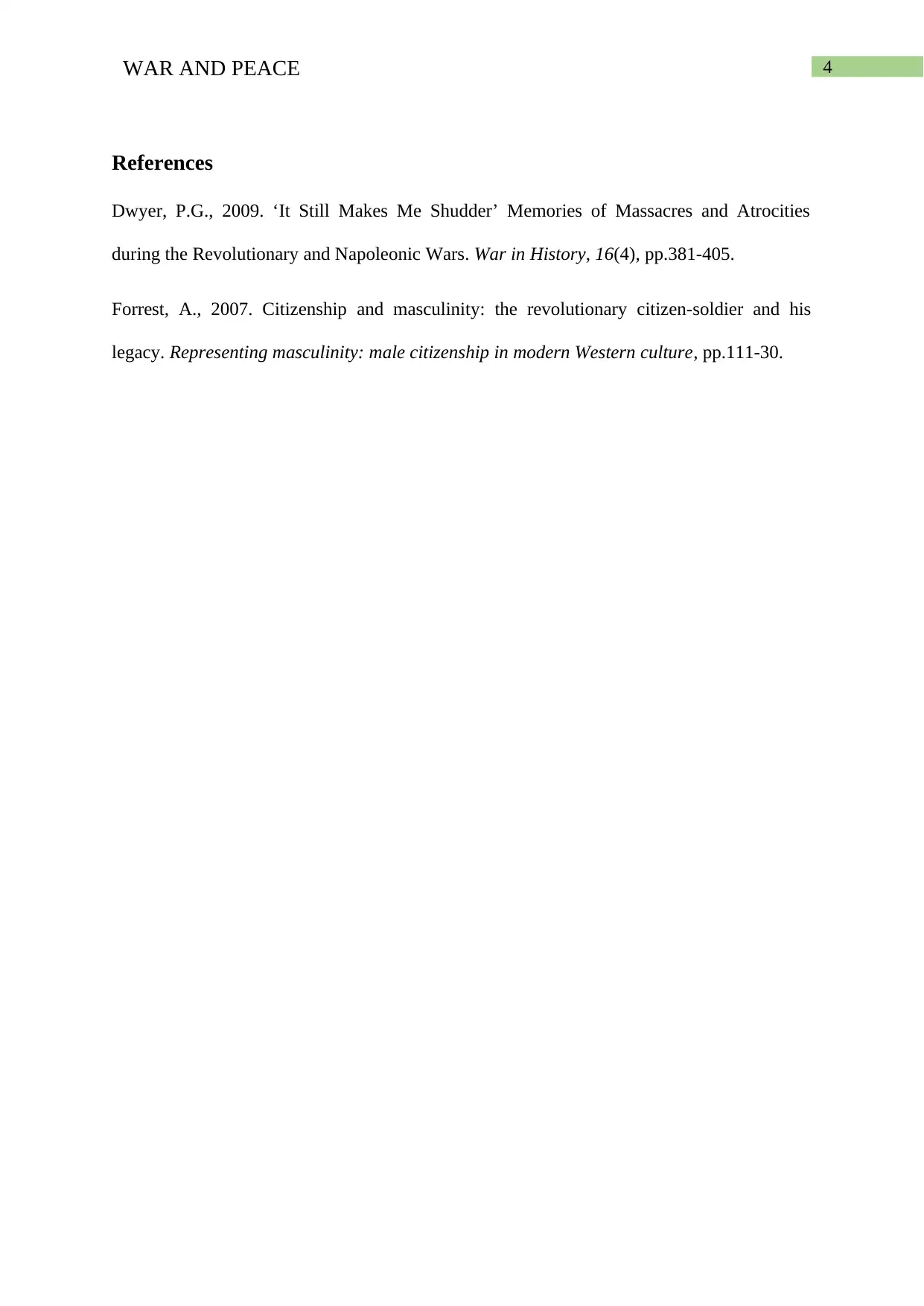
4WAR AND PEACE
References
Dwyer, P.G., 2009. ‘It Still Makes Me Shudder’ Memories of Massacres and Atrocities
during the Revolutionary and Napoleonic Wars. War in History, 16(4), pp.381-405.
Forrest, A., 2007. Citizenship and masculinity: the revolutionary citizen-soldier and his
legacy. Representing masculinity: male citizenship in modern Western culture, pp.111-30.
References
Dwyer, P.G., 2009. ‘It Still Makes Me Shudder’ Memories of Massacres and Atrocities
during the Revolutionary and Napoleonic Wars. War in History, 16(4), pp.381-405.
Forrest, A., 2007. Citizenship and masculinity: the revolutionary citizen-soldier and his
legacy. Representing masculinity: male citizenship in modern Western culture, pp.111-30.
1 out of 5
Your All-in-One AI-Powered Toolkit for Academic Success.
+13062052269
info@desklib.com
Available 24*7 on WhatsApp / Email
![[object Object]](/_next/static/media/star-bottom.7253800d.svg)
Unlock your academic potential
Copyright © 2020–2025 A2Z Services. All Rights Reserved. Developed and managed by ZUCOL.

